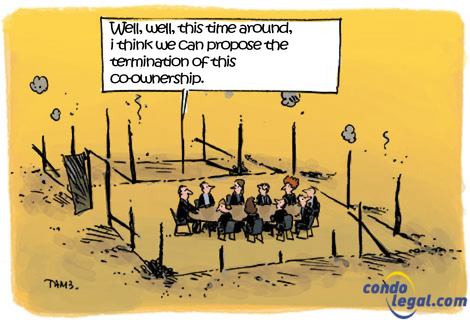Termination and liquidation of the co-ownership

The divided co-ownership of a building is not necessarily intended to last for eternity. The end of the co-ownership, and therefore the dissolution and liquidation of the syndicate, is justifiable, for various reasons. The dissolution of a co-ownership leads to a liquidation process. This process is regulated by articles 1108 and 1109 of the Civil Code of Québec, which refer to the rules applicable to legal persons concerning their liquidation.The question of putting an end to your co-ownership may one day arise. There are therefore various questions to be asked about this approach.
What are the reasons for terminating a co-ownership? What are the modalities and consequences of a dissolution? Answers in this fact sheet!
- Causes for which a co-ownership can end
Several reasons may justify the termination of a co-ownership. This is the case when there is the:
- Partial or total destruction of the immovable, followed by a decision of the general meeting of the co-owners not to rebuild it;
- Impossibility to rebuild the immovable following a loss, due to new regulatory or legislative standards (loss of acquired rights);
- Insufficiency of the syndicate’s insurance coverage and the economic incapacity of the co-owners to pay the shortfall to allow rebuilding the immovable following a loss;
- Partial or total expropriation of the immovable;
- Stalemate within a small co-ownership, thus preventing any decision to be taken by the general meeting of the co-owners and the Board of Directors;
- The unification of all the units in the hands of the same owner, such as for example, if the co-ownership comprise two units (a duplex) that have become the property of the same owner.
- Modalities of a dissolution
- Decision of the general meeting of the co-owners
The decision to terminate the co-ownership is taken by the general meeting. Such a decision requires a favorable vote of at least three-quarters (75%) of all the co-owners representing 90% of the votes of all the votes of the co-ownership. It must then be recorded in a document signed by the syndicate.
- Veto right of the hypothecary creditor
The assent of all creditors holding hypothecs on all or a part of the immovable is also required. The decision of the general meeting must be accompanied by the written consent of all the hypothecary creditors.
-
In case of the total or partial destruction of the immovable
When the immovable has been affected by a major event resulting in a major loss, the issue of terminating the co-ownership arises. As a result, it is generally stipulated in the declaration of co-ownership that the Board of Directors is required to convene a special general meeting within ninety (90) days of the occurrence. At this meeting, and after being informed by the Board of Directors of the costs of rebuilding, the deadlines and other details, the meeting decides whether or not to terminate the co-ownership.
In the event it is decided to terminate the co-ownership, the insurance trustee appointed by the syndicate must determine the share of the insurance indemnity of each co-owner based on the relative value of their fraction. From this share and up to the amount of such share, the hypothecary creditors and prior claims holding rights upon the private portion of each co-owner are paid according to their rank. To this end, he must follow the rules of article 2497 of the Civil Code of Quebec. The remaining amounts are transferred to the liquidator of the syndicate.
- Consequences of the termination of a co-ownership
The termination of the co-ownership implies the dissolution of the co-ownership and of the syndicate of co-owners. The procedures to be observed are essentially the same one as for the dissolution of legal persons:
- Liquidator
The liquidator's mission is, as a first step, to settle the debts of the syndicate and recover its receivables. He acts as the administrator of the property of others charged with full administration, thus enabling him to recover unpaid common expenses from a co-owner.
He then proceeds to the partition of the assets between the co-owners. Prior claims and hypothecary creditors holding rights upon the private portions of the co-owners are paid in priority according to their rank. As for the balance, the liquidator remits it to the co-owners. At all times, the liquidator must use the relative value of their fraction in his calculations of the amounts to be reimbursed to the co-owners and their hypothecary creditors.
He has five years, from the publication of the notice of dissolution, to close the liquidation of the syndicate. This liquidation takes the form of a notice of closure signed by the liquidator and published in the Land Registry.
- Registrar of entreprises
The Board of Directors must send a notice of dissolution to the Registrar of Enterprises, by filing a declaration to this end. This notice, entitled Notice of dissolution –legal person (RE-803), must thus be completed and sent to the office of the registrar of enterprises.
 WHAT YOU SHOULD KNOW! In the event of the complete or partial destruction of the immovable, the termination of the co-ownership does not occur by the simple operation of the Law. It must be decided by the general meeting of the co-owners. If the immovable is rebuilt, the syndicate remains in existence.
WHAT YOU SHOULD KNOW! In the event of the complete or partial destruction of the immovable, the termination of the co-ownership does not occur by the simple operation of the Law. It must be decided by the general meeting of the co-owners. If the immovable is rebuilt, the syndicate remains in existence.
 WHAT TO KEEP IN MIND: The dissolution of a co-ownership necessitates a liquidation process, which involves, without limitation, the payment of the debts owing (as the case may be) of the syndicate of co-owners which no longer exists. Its liquidator is appointed by the directors (Board of Directors).
WHAT TO KEEP IN MIND: The dissolution of a co-ownership necessitates a liquidation process, which involves, without limitation, the payment of the debts owing (as the case may be) of the syndicate of co-owners which no longer exists. Its liquidator is appointed by the directors (Board of Directors).
 WARNING! During the liquidation of the co-ownership, the co-owners may neither sell nor hypothecate their private portion without the authorization of the liquidator. The latter shall thus intervene in any deed as he holds all the rights of the co-owners in the immovable (private and common portions)
WARNING! During the liquidation of the co-ownership, the co-owners may neither sell nor hypothecate their private portion without the authorization of the liquidator. The latter shall thus intervene in any deed as he holds all the rights of the co-owners in the immovable (private and common portions)
Back to factsheets